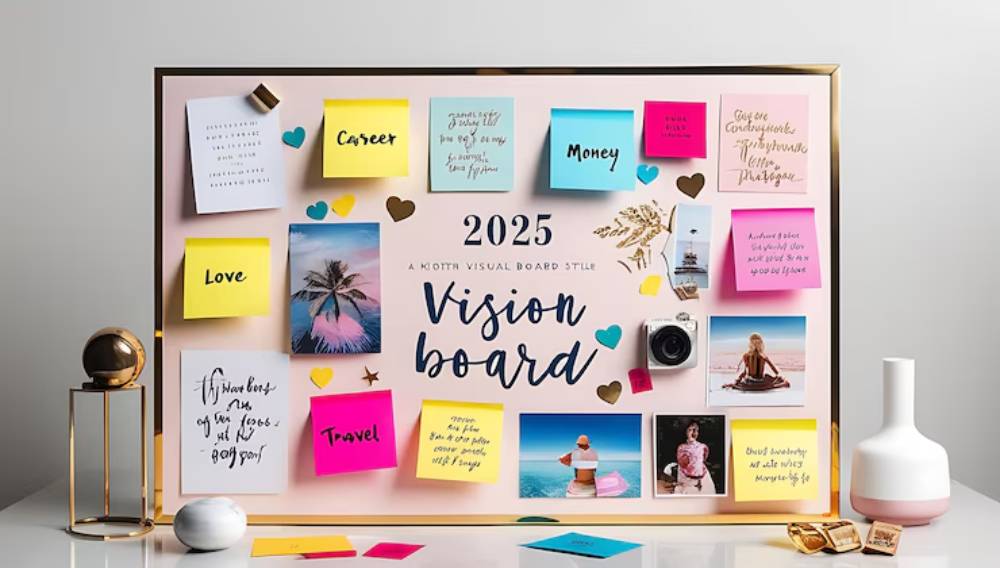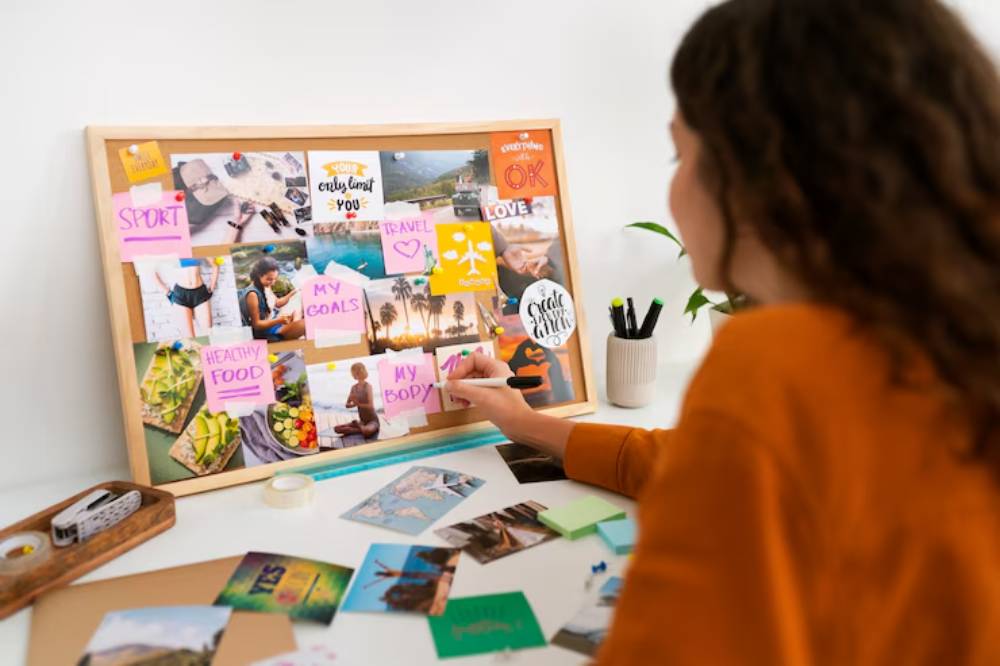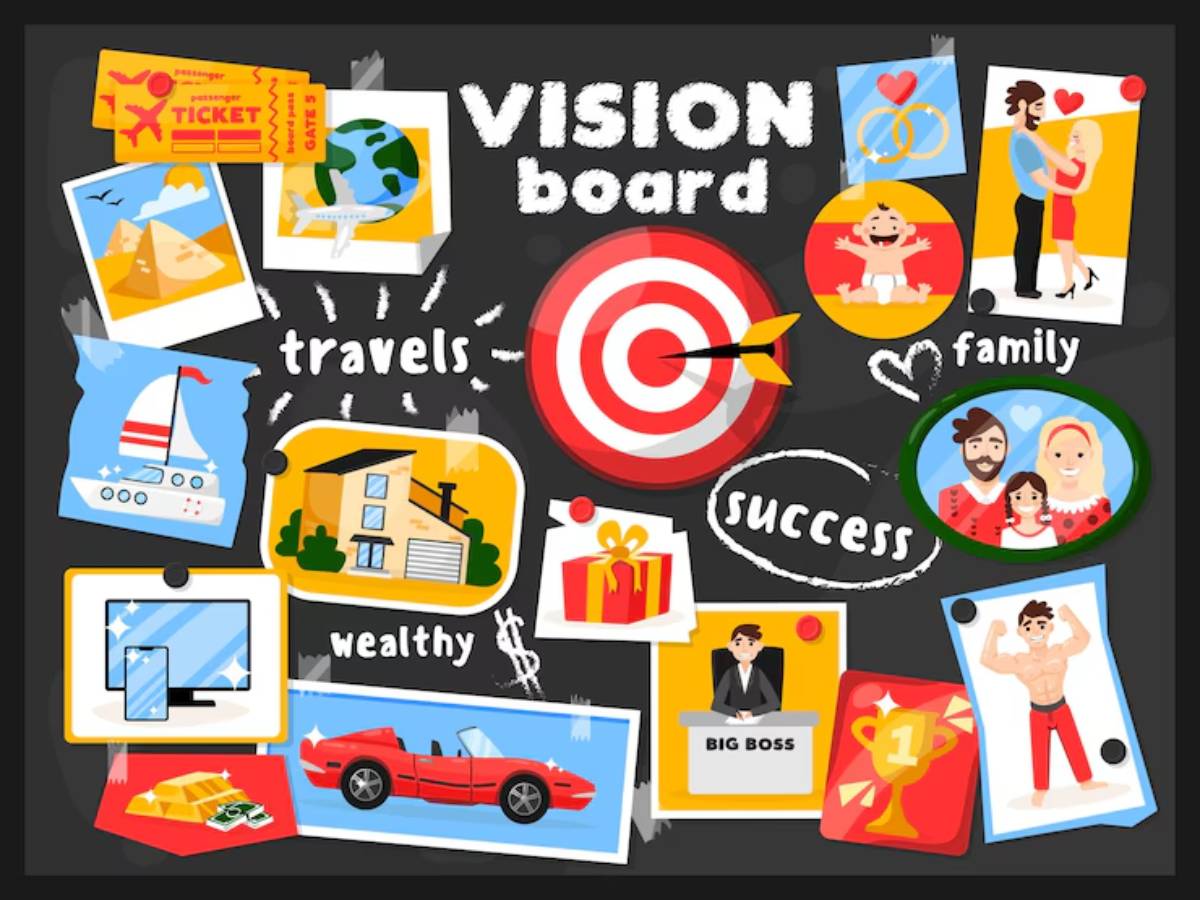
What Is a Vision Board and How It Shapes Your Future
There’s a quiet power in cutting out magazine clippings, pinning digital images, and arranging words and quotes that speak to who someone hopes to become. It might seem simple—like scrapbooking for dreamers—but this practice, known as vision boarding, holds deeper potential than meets the eye.
So what exactly is a vision board? Why has it become such a go-to among those exploring manifestation, personal development, and intentional living? And how can something as visual as a board genuinely shape your future?
Let’s explore the vision board meaning, its connection to future visualisation, and why it continues to rise as one of the most enduring and accessible manifestation tools around.
Understanding the Vision Board Meaning

At its core, a vision board is a visual representation of goals, dreams, and aspirations. It can be physical (like a corkboard or poster) or digital (via apps, Pinterest, or design platforms). The format doesn’t matter nearly as much as the intention behind it.
A vision board typically includes:
- Images that represent dreams or life goals
- Quotes or affirmations that inspire action or reflection
- Words or symbols tied to specific themes (career, love, health, travel, etc.)
- Sometimes, tangible objects (tickets, notes, or reminders)
It’s not about artistic perfection. It’s about creating a space where desires can be seen, felt, and emotionally connected with—daily.
Why a Vision Board Works
Skeptics might wonder: can cutting and pasting images really influence outcomes? The short answer is—yes, when paired with clarity and consistent future visualisation.
Here’s how vision boards help shape what’s next:
1. They Anchor Intention
A goal that only lives in the mind is easy to forget, especially when life gets busy. A vision board brings it to life—making it tangible, visible, and hard to ignore.
2. They Engage the Subconscious Mind
The brain loves images. In fact, visual inputs are processed 60,000 times faster than text. By seeing goals repeatedly, the subconscious starts aligning behaviour to match them.
3. They Trigger Daily Motivation
Think of a vision board as a silent coach hanging out in your space, reminding you of what you’re working toward, nudging you when you forget, and cheering you on quietly from the corner.
4. They Bridge the Gap Between Dreams and Action
When used intentionally, a vision board becomes more than a wishlist—it transforms into a visual map that makes the distant future feel closer, realer, and reachable.
The Science Behind Future Visualisation
While vision boards are often linked to spiritual or emotional growth, there’s actual neuroscience behind the practice.
Studies in sports psychology, for example, show that visualisation—imagining success in vivid, sensory detail—activates the same parts of the brain as real-life practice. Olympic athletes have used it to improve performance for decades.
Apply that to life goals, and the pattern holds: envisioning outcomes improves focus, motivation, and resilience. A vision board is simply the canvas that houses those mental rehearsals.
Types of Vision Boards (And What They Reveal)
Just like dreams vary, so do boards. Here are a few styles people gravitate toward—and what they reflect.
1. Theme-Based Boards
Created around a specific area of life (career, relationships, self-love, etc.). They offer focused clarity and can be especially helpful during transitions.
2. Mood Boards
Less about goals and more about feeling. Think aesthetics, colours,and textures. These appeal to creatives and are great for setting lifestyle intentions.
3. Timeline Boards
Organised by months or milestones. Perfect for those who love planning and want to track progress step by step.
4. Mixed Style (Most Common)
A collage that blends images, quotes, and symbols from different life areas. It’s like a life trailer—previewing everything one hopes to experience soon.
For a closer look at formats and which might fit your personality, take a peek at How to Create a Vision Board That Actually Works.
Vision Boards and the Law of Attraction
Many who create vision boards are also drawn to the Law of Attraction—the idea that focusing on positive or desired outcomes draws them into one’s life.
Whether one fully embraces this philosophy or simply views it as a mindset tool, vision boards play a powerful role in anchoring that focus.
They offer:
- A space for energetic alignment
- A daily reminder to stay in the feeling of “already having”
- Emotional connection, which fuels sustained attention
There’s something magical about seeing goals laid out visually—it shifts desire from abstract to attainable.
Tips for Creating a Vision Board That Shapes Your Future
Creating a board isn’t complicated—but making one that truly connects and motivates takes intention.
Here’s what helps:
1. Get Clear on What You Want
Before opening a magazine or Pinterest board, sit with a journal.
Ask:
- What am I craving more of in life?
- What does success look and feel like?
- What lights me up—even if it scares me?
Clarity before creativity is key.
2. Choose Images That Evoke Emotion
Don’t pick an image of a mansion just because it looks impressive. Choose visuals that trigger a feeling—security, freedom, joy, inspiration. Emotion drives motivation.
3. Include Words and Affirmations
Words give structure. Add mantras, power phrases, or single words that act as emotional anchors. They ground the visual energy with language.
4. Leave Space for the Unexpected
Your life isn’t static—your board doesn’t have to be either. Leave space to add or shift as new desires surface or goals evolve.
5. Display It Where You’ll See It

Don’t hide your board in a drawer. Whether it’s by your bed, near your desk, or the lock screen on your phone—visibility is power.
How Vision Boards Shape the Future (In Practice)
Let’s bring it back to real life. Here’s how a vision board can influence someone’s path beyond intention.
- Career: A board showing freedom, creativity, and flexible workspaces might prompt someone to finally explore remote freelance gigs.
- Relationships: Repeated images of loving couples, deep conversations, and travel with a partner might cause someone to rethink what they’re settling for.
- Wellness: A board filled with joyful movement and healthy meals may lead to subtle changes—like drinking more water or rejoining a yoga class.
It’s not about magic. It’s about consistent future visualisation that inspires small shifts—ones that stack over time.
What a Vision Board Is Not
Let’s clear up a few myths.
- It’s not a wish list for the universe to fulfill while one sits back passively.
- It’s not a competition—there’s no “perfect” way to create one.
- It’s not static—updating and evolving the board is part of the process.
Ultimately, it’s not about manifesting the exact image pinned to the board—it’s about becoming the person who lives in alignment with those dreams.
To explore this deeper, visit The Psychology Behind Why Vision Boards Work.
Why It’s Worth Trying
Everyone dreams. But not everyone gives those dreams a home.
A vision board is that home. A place where your future self can leave notes. A place to remember what lights you up. A place to return to when distractions, doubt, or detours try to lead you astray.
And in a world of to-do lists and scrolling feeds, it offers something surprisingly rare—a moment of clarity.
So, whether you’re launching a new chapter or simply craving more intention, pause. Reflect. Then pick up the scissors or open the app. Give those dreams a space to live.
Who knows? A single image could change everything.


